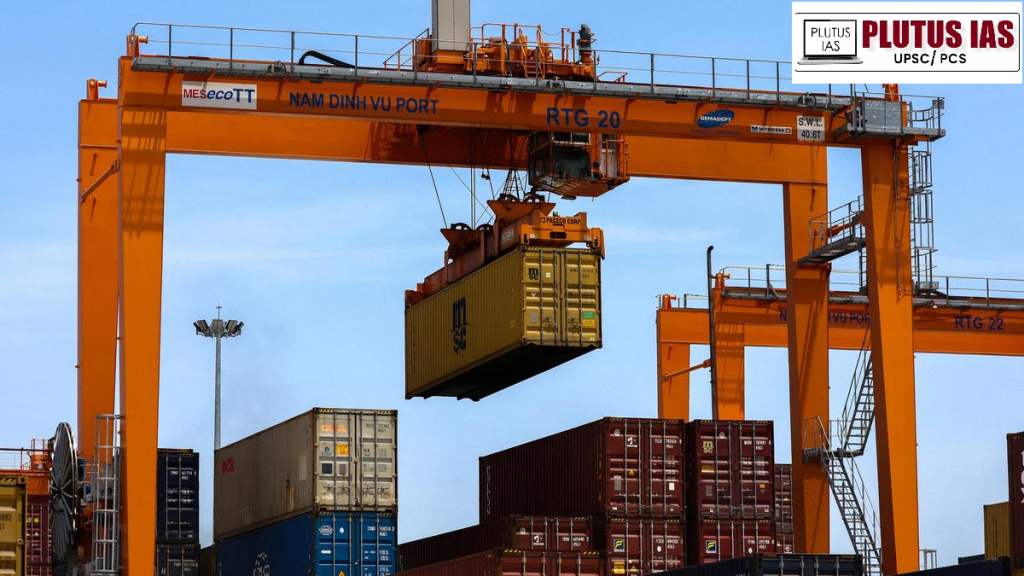What India Wants:
1. Elimination of high U.S. tariffs on labour-intensive exports like garments, textiles, leather goods, and gems & jewellery.
2. Full exemption from the suspended 26% reciprocal tariffs, set to be reinstated on July 9 if talks fail.
3. Retention and expansion of market access in key U.S. sectors to protect Indian export competitiveness.
4. Fairtrade terms for MSMEs, which dominate India’s high-employment export sectors.
What the U.S. Wants:
1. Greater access to India’s agriculture and dairy sectors, including products like apples, tree nuts, and genetically modified crops.
2. Tariff cuts on U.S. industrial goods, particularly electric vehicles, petrochemicals, and wines.
3. Opening up of sensitive trade segments, where India has traditionally maintained protective barriers.
Tariff Landscape and Trade Imbalances
1. Reciprocal Tariff Threat Looms: The U.S. imposed a 26% reciprocal tariff on Indian goods on April 2, which was temporarily suspended for 90 days. This suspension will expire on July 9 if no agreement is reached.
2. India Demands Full Exemption: India is pushing for complete removal of the 26% tariff, citing its negative impact on export competitiveness and MSME-driven sectors.
3. Market Access Eroded by Tariff Barriers: Indian exporters face high MFN tariffs and country-specific surcharges in the U.S., undermining their ability to compete in the American market.
4. No Fast-Track Mechanism in U.S.: The U.S. lacks fast-track trade authority, which restricts its ability to make swift and broad tariff concessions through trade negotiations.
5. Labour-Intensive Sectors Most Affected: Key Indian exports like textiles, footwear, leather, and ceramics are subject to 8–20% tariffs, severely hurting their global price competitiveness.
Labour-Intensive Sectors: India’s Core Concern
1. Export Engines of Employment: India’s exports of textiles, garments, leather goods, carpets, and gems are critical employment generators, especially for MSMEs and traditional sectors.
2. Robust Trade Contribution: These sectors contributed over USD 14.3 billion in exports to the U.S. in FY25, forming a substantial portion of bilateral trade.
3. Support for Rural & Women Employment: These industries are rooted in rural and semi-urban economies, providing jobs to artisans and women, thereby boosting inclusive growth.
4. Regional Economic Pillars: Major beneficiary states include Uttar Pradesh, Tamil Nadu, Gujarat, and West Bengal, where these industries form the backbone of local economies.
5. Non-Negotiable Tariff Relief: India maintains that tariff relief for these sectors is non-negotiable, as political sustainability and domestic jobs depend on it.
Agriculture and Dairy: India’s Red Line
1. U.S. Demands Market Access: The U.S. is pushing for access to India’s agriculture and dairy sectors, including products like GM crops, apples, tree nuts, and dairy goods.
2. Sustenance Farming Dominates India: India resists such access due to its sustenance farming structure, where most farmers operate on small landholdings.
3. Dairy Sector Remains Off-Limits: India has never opened its dairy sector under any FTA, given its deep linkages to small producers and cooperative models.
4. Political and Economic Sensitivity: Agriculture and dairy are politically sensitive sectors, involving the livelihoods of millions and deeply tied to rural stability.
5. Risk of Domestic Backlash: Concessions in these areas could trigger domestic opposition and agricultural disruption, making them India’s firm red lines in negotiations.
Geopolitical and Strategic Dimensions
1. Beyond Trade: Strategic Alignment The trade talks are embedded within broader India-U.S. strategic cooperation, including defence, technology, and the Indo-Pacific.
2. Indo-Pacific Cooperation Boost: A successful trade pact could strengthen Indo-Pacific partnerships, especially amid China’s growing economic clout.
3. Counterbalance to China: A deeper economic alignment could serve as a counterweight to China’s influence in global trade and supply chains.
4. Long-Term Strategic Convergence: The deal would reinforce shared values around economic resilience, democratic trade norms, and secure supply chains.
Trade Statistics Snapshot
1. Apr–May FY26 Trends: India’s merchandise exports to the U.S. rose 21.78% to USD 17.25 billion, and imports rose 25.8% to USD 8.87 billion.
2. FY25 Export Surge: Indian exports to the U.S. climbed to USD 86.5 billion in FY25 from USD 77.5 billion in FY24 — an 11.6% increase.
3. Sector-Wise Export Highlights: Labour-intensive sectors like garments, footwear, leather, textiles, and ceramics accounted for over USD 14.3 billion in FY25.
4. Bilateral Trade Ambition: The current bilateral trade of USD 191 billion is aimed to be more than doubled to USD 500 billion by 2030.
Challenges and Sticking Points
1. Absence of U.S. Fast-Track Authority: The U.S. lacks fast-track trade approval powers, limiting its ability to reduce Most Favoured Nation (MFN) tariffs across the board.
2. India’s Firm Stance on Agriculture and Dairy: India remains unwilling to concede in these politically sensitive sectors, citing farmer livelihoods and rural stability.
3. Mutual Political Constraints: Both countries face domestic political pressures—the U.S. from its agricultural lobbies and India from farmer and MSME constituencies.
4. Trust Deficit & Tariff Volatility: The sudden imposition and suspension of tariffs (like the 26% reciprocal duty) has created uncertainty and a lack of trust between negotiators.
Way Forward
1. Seal an Interim Deal Before July 9: Finalize a limited agreement to prevent the reimposition of the 26% tariff and maintain trade stability.
2. Prioritize Labour-Intensive Sectors: Ensure tariff cuts on textiles, leather, and gems to protect MSMEs and safeguard rural employment.
3. Offer Calibrated Agricultural Access: Allow selective U.S. agri-imports (like almonds or apples) with strict standards, while firmly excluding dairy and GM crops.
4. Create Trust-Building Mechanisms: Set up an early-warning system and dialogue channel to manage tariff shocks and policy unpredictability.
5. Align Trade with Strategic Ties: Use convergence in defence, semiconductors, and clean energy to unlock broader trade cooperation.
6. Institutionalize Bilateral Trade Platforms: Establish a permanent India–U.S. Trade Council to fast-track negotiations and resolve disputes systematically.
7. Lay Groundwork for a Full FTA: Use the current talks as a stepping stone toward a long-term, rules-based and comprehensive trade agreement.





No Comments